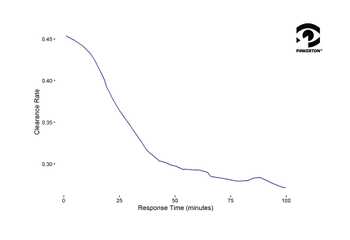This blog is a part of our series, "Perspectives in Crime" where we explore leading academic studies that touch on crime data.
Policing agencies are naturally concerned with quickly responding to calls for service. Rapid police response can prevent violence, facilitate the gathering of information and evidence, and potentially increase the likelihood of capturing an offender. Despite these intuitive reasons for believing quicker response times should result in more effective policing, it has been a limited focus of criminological study, and the results these studies have offered are often counter intuitive.
The first criminological study on police response time was based in Kansas City in the 1970s (Pate et al, 1976). The Kansas City study assessed the relationship between police travel time and arrests at the scene of the crime, finding unexpectedly that shorter police response time had little bearing on the apprehension of an offender or the clearance rate. The clearance rate represents the percentage of recorded crimes that resulted in an arrest and charges being filed.
In the 40 years since the Kansas City Study, advances in communication and technology have changed many facets of law enforcement and society. Jordi Blanes i Vidal and Tom Kirchmaier, two professors at the London School of Economics, revisited the question of police response time in their paper, The Effect of Police Response Time on Crime Clearance Rates, published in the Review of Economic Studies in 2017. Vidal and Kirchmaier utilized internal data from the Greater Manchester Police Department from 2008-2014, surveying some 300,000 crimes. Exploiting natural variation in the distance of crime scenes to police stations peppered across the region, Vidal and Kirchmaier assessed the statistical relationship between response times and both short and long-term clearance rates.
Calls for service requiring emergency or priority response are typically handled by a member of a response team, regardless of proximity of neighborhood patrol officers. Police calls are assigned a severity grade by the call handler, with the two most severe grades (which this study focused on) being emergency responses where the target time is to have an officer on scene within 15 minutes, and priority responses where the target time for an attending officer is within 60 minutes. Call handlers assign grades based on both official guidelines and personal judgement but typically assign emergency status when there is an imminent threat or indication of ongoing violence. Of the crimes surveyed in this study, approximately 31% were classified to a Grade 1 priority level.
After arriving at a scene, response officers interview the victim/caller, any other witnesses, and engage in a preliminary onsite investigation. After this initial investigation, any necessary additional investigation is passed to a neighborhood officer or detective depending on the severity of offense.
How police reponse time affects incident clearance
Several mechanisms pertain to police response time and its relation to the clearance of incidents. If the crime is still in progress, the arriving officer can apprehend the offender. If the offender has left the scene, timely response may facilitate launching an effective search for the offender. Arrests made within 15 minutes of police arriving on a scene are associated with a much higher clearance rate. These immediate arrests have an 85% clearance rate, where crimes without an immediate arrest have a 34% clearance rate.
The plot below shows the relationship from the Greater Manchester Police project between response times and clearance rates, demonstrating the significant returns to timely police response in terms of offender apprehension.

Rapid arrival also increases the likelihood of utilizing eyewitness testimony, as well as more accurate and useful testimony from victims and witness alike. Importantly, rapid arrival appeared to impact the likelihood that victims and witnesses effectively name a suspect to investigating officers. Among the Greater Manchester Police dataset, crimes with a named suspect are cleared 65% of the time, while crimes with no named suspect have a much lower clearance rate of 29%. Vidal and Kirchmaier found that a 10% increase in response time is associated with a 1.4% decrease in the likelihood of a suspect being named. Rapid response inspires confidence in the competency and engagement of police services which might encourage stronger cooperation, the authors theorize.
In what might be considered the most direct refutation of the Kansas City study, Vidal and Kirchmaier report a significant link between response times and crime clearance rates, estimating that a 10% increase in response time produces a 4.7% decrease in the clearance rate. They also find that for cleared crimes, police take less time to clear the crime when the initial call response was faster. These effects hold true for both violent crimes and thefts, though they are larger for the latter. This study supports the intuitive mechanisms of how and why faster response times produce a higher clearance rate. The longer the response time, the less likely a victim or witness can name a suspect. The faster the response time, the greater the likelihood of an immediate arrest.
Effective risk management demands reliable estimates of response times from emergency services. In the fast-emerging world of evidence-based security, understanding local response time can allow for more intelligent allocation of guardianship resources across the portfolio of properties, assets and persons in the care of risk management professionals.
Sources:
Blanes I Vidal, J. and Kirchmaier, T. (2017). The effect of police response time on crime clearance rates. Review of Economic Studies.
Pate, T., Ferrara, A., Bowers, R. A., and Lorence, T. (1976), “Police Response Time: Its Determinants and Effects”, Washington DC: Police Foundation.





